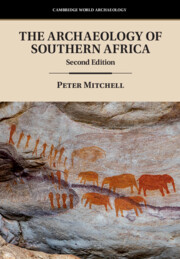Book contents
- Frontmatter
- Contents
- List of Figures
- List of Tables
- Acknowledgments
- 1 Introduction
- 2 Frameworks
- 3 Contexts
- 4 Origins
- 5 A Cognitive Revolution
- 6 Hunter-Gatherers of the Late Pleistocene
- 7 Archaeologies of the Pleistocene/Holocene Transition
- 8 Hunting, Gathering, Intensifying: Forager Histories in the Holocene before 2000bp
- 9 Taking Stock: Herders and Hunter-Gatherers
- 10 Farmers and Foragers: the First Millennium
- 11 Forming States: the Zimbabwe Culture and its Neighbours
- 12 Recent Farmers and Hunter-Gatherers in Southernmost Africa
- 13 Colonisation, Conquest, Resistance
- 14 Perspectives and Prospects
- Glossary
- References
- Index
1 - Introduction
Published online by Cambridge University Press: 15 May 2024
- Frontmatter
- Contents
- List of Figures
- List of Tables
- Acknowledgments
- 1 Introduction
- 2 Frameworks
- 3 Contexts
- 4 Origins
- 5 A Cognitive Revolution
- 6 Hunter-Gatherers of the Late Pleistocene
- 7 Archaeologies of the Pleistocene/Holocene Transition
- 8 Hunting, Gathering, Intensifying: Forager Histories in the Holocene before 2000bp
- 9 Taking Stock: Herders and Hunter-Gatherers
- 10 Farmers and Foragers: the First Millennium
- 11 Forming States: the Zimbabwe Culture and its Neighbours
- 12 Recent Farmers and Hunter-Gatherers in Southernmost Africa
- 13 Colonisation, Conquest, Resistance
- 14 Perspectives and Prospects
- Glossary
- References
- Index
Summary
This chapter begins by highlighting southern African archaeology’s importance at a global level, stressing the enormous time-depth over which hominins have been present in the region, the diversity of its archaeological record, and the contributions that this has made and continues to make to broader debates within archaeology and anthropology. Next, it indicates key changes made here relative to the first edition of this book in 2002 and then identifies the main sources of evidence available for reconstructing southern Africa’s past. These include archaeology, palaeoclimatic and palaeoenvironmental science, ethnographic data, historical linguistics, genetics, and oral and written histories. The chapter then introduces the overall structure of the book, ending with a discussion and justification of some key matters of nomenclature regarding how southern Africa’s varied inhabitants have been/should be called. Guidance is also given on matters of orthography relative to sounds not used in English.
- Type
- Chapter
- Information
- The Archaeology of Southern Africa , pp. 1 - 10Publisher: Cambridge University PressPrint publication year: 2024

